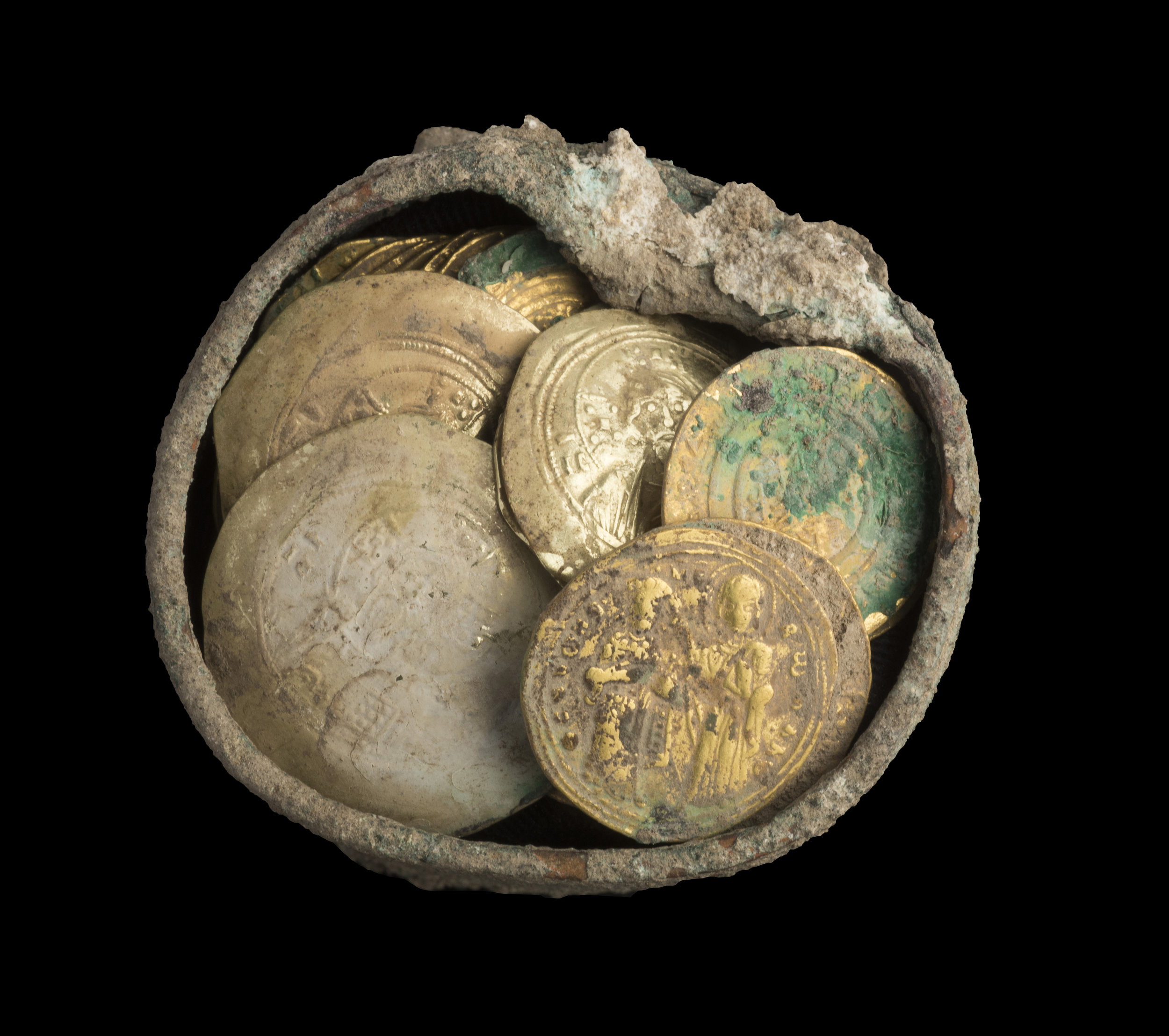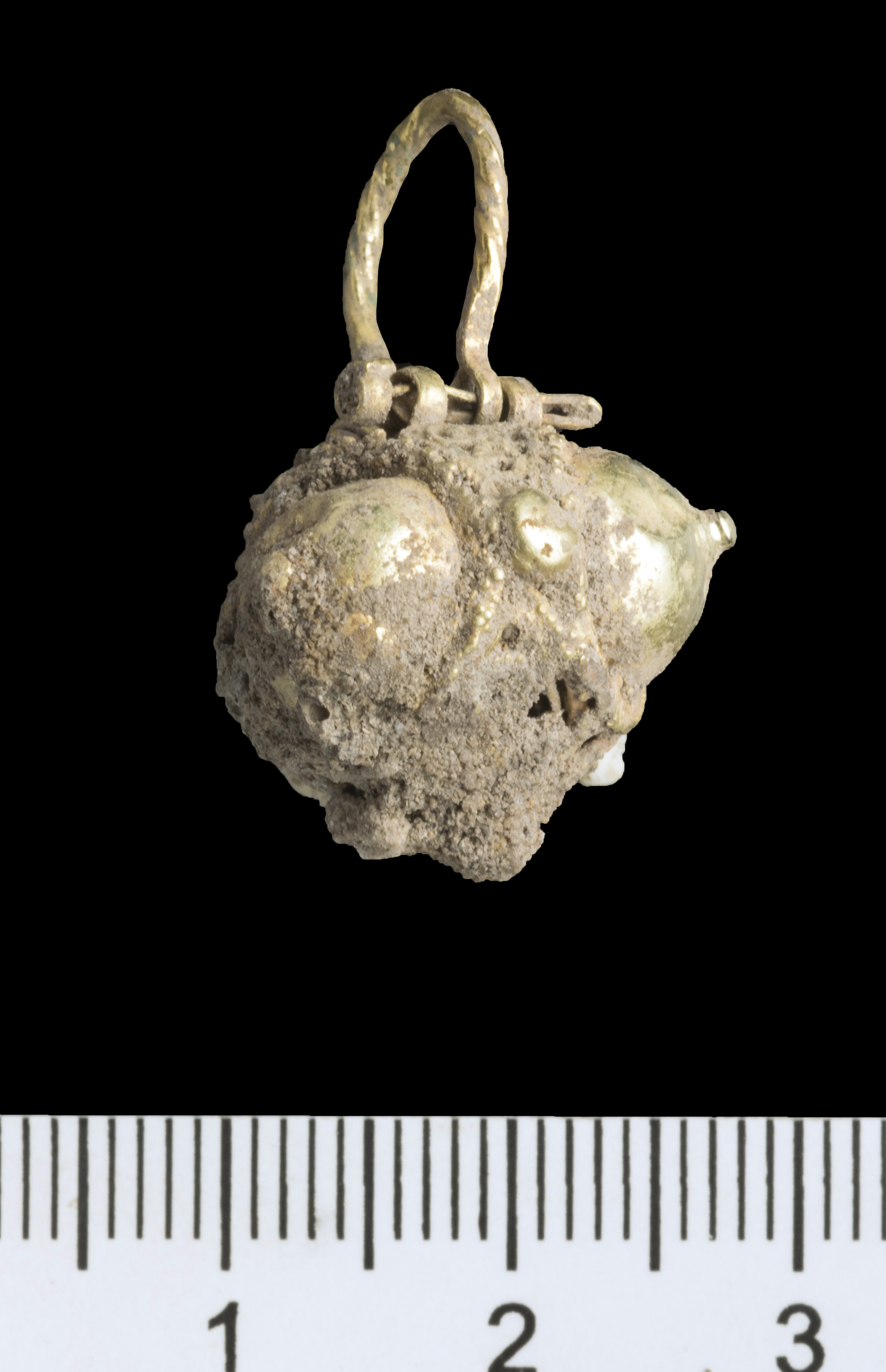Gold trove hidden in Caesarea during crusader conquest recovered 900 years latter by archaeologists
This Hanukkah archaeologists discovered, quite literally, a hidden treasure in the port town of Caesarea. Lodged between two stones in the side of a well, the excavators were surprised to find a small bronze pot. The treasure within was even more astounding: a collection of 24 gold coins together with a gold earring. The treasure dates to the Abbasid and Fatimid periods, some 900 years ago. How did such a treasure find its way into the well? Who put it there, and why?
Caesarea Maritima, the bronze pot with gold earring inside Photo: Yaniv Berman, courtesy of the Caesarea Development Corporation
These are questions which Dr. Peter Gendelman and Mohammed Hatar, the Israel Antiquities Authority (IAA) archaeologists directing the dig at Caesarea, immediately began to ask. The well where the cache was hidden is located in a residential area from the Abbasid and Fatimid periods. According to Gentleman and Hatar, ”The coins in the cache dating to the end of the eleventh century make it possible to link the treasure to the Crusader conquest of the city in the year 1101, one of the most dramatic events in the medieval history of the city.” Most likely the gold was hidden by a wealthy Caesarean who aimed to reclaim it after the impending battle had subsided.
Caesarea Maritima, the rare cache found on site. Photo: Yaniv Berman, courtesy of the Caesarea Development Corporation
Tragically, the gold was never retrieved. According to historical sources, when the Crusader King of Jerusalem, Baldwin I (1100–1118), attacked Caesarea his army massacred the city and it’s residents. Gendelman and Hatar say that “It is reasonable to assume that the treasure’s owner and his family perished in the massacre or were sold into slavery, and therefore were not able to retrieve their gold."
“The cache is a silent testimony to one of the most dramatic events in the history of Caesarea — the violent conquest of the city by the Crusaders. Someone hid their fortune, hoping to retrieve it — but never returned.”
This tragic scenario is not an isolated case. According to the IAA’s press release, this discovery was found close to the location of two other treasures from the same period. The first, a pot consisting of gold and silver jewelry, was discovered in the 1960s. The second, a collection of bronze vessels, was found in the 1990s. These treasures are currently displayed at the Israel Museum in Jerusalem.
Caesarea Maritima, preliminary identification of the coins on site. Photo: Yaniv Berman, courtesy of the Caesarea Development Corporation
Apart from the intriguing story which the treasure-in-the-well tells, this discovery is significant because of the nature of the coins themselves. Dr. Robert Kool, coin expert at the IAA, says that "The cache is of a unique combination of coins not yet seen in Israel consisting of two types of coins…” First, the collection contains 18 Fatimid dinars which were the standard currency in Caesarea at the time. Second, however, are 6 Byzantine imperial gold coins which are extremely rare. Five of these date to the reign of Byzantine Emperor Michael VII Doukas (1071–1079), and were not circulated locally. This suggests there were trade relations between Caesarea and Constantinople during the period. Kool says that “One or two of these gold coins were the equivalent of the annual salary of a simple farmer, so it seems that whoever deposited the cache was at least well-to-do or involved in commerce.”
This is little surprise considering that, as the levant’s primary port, Caesarea has been a critical link in trade routes since it was constructed by Herod the Great. Excepting Acco, Israel’s coast had little by way of natural ports. Herod’s ambitious and impressive feat in constructing an artificial port at Caesarea using under-water cement changed the nature of coastal trade in Israel.
Aerial photos of Caesarea ancient port. Photo: Yaakov Shimdov, Israel Antiquities Authority
“Since its founding 2,030 years ago, and throughout the periods which followed, Caesarea has been a vibrant port city. Its significance and architectural wealth have made it one of the most important cities of the Roman and Byzantine empires. ”
Excavations which lead to the coins’ discovery are sponsored by the Edmond de Rothschild Foundation, which is investing NIS 150 million in conserving and excavating Caesarea. Guy Swersky, Vice Chairman of the Edmond de Rothschild Foundation, said that the discovery of the coins “reaffirms the importance of the fund's decision…to conserve and restore the Old City and the port, making it accessible to hundreds of thousands of tourists from Israel and around the world.”
For over two years, the Caesarea Development Corporation has been engaged in exposing the port’s large vaults which were used during the peak of Caesarea’s glory. As this project draws to a close, Michael Karsenti, CEO of the Caesarea Development Corporation, said that “It is symbolic that the gold coins were discovered on the eve of Hanukkah. For us, this is certainly 'Hanukah gelt,’ and a testament to how much more is still hidden within Caesarea.”
What other treasures does Caesarea have to reveal? Only time will tell. Karsenti invites the public to visit Caesarea during the Hanukkah season to view this amazing discovery. Karsenti also emphasized that in addition to uncovering the treasures in the vaults of the Herodian Temple, work continues at the site of the ancient synagogue whose mosaic floor has been partially restored.
“Ancient Caesarea…never ceases to surprise, and reveals ever more of its exciting and fascinating history. We, along with all of the entities involved in the conservation of the treasures and architectural richness of Caesarea National Park, have the duty and privilege to preserve the heritage of ancient Caesarea for the benefit of the entire public as well as for future generations.”
Abby VanderHart, FIAA Contributor











